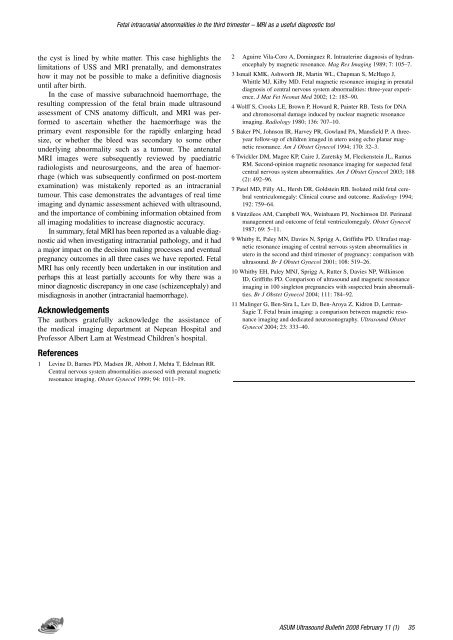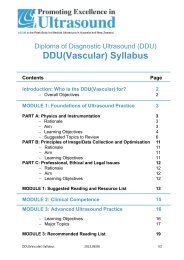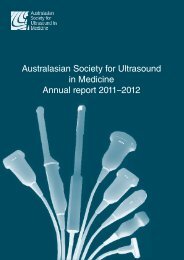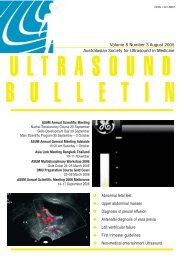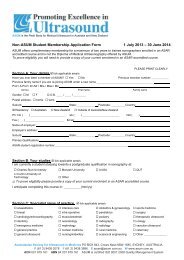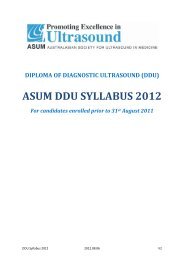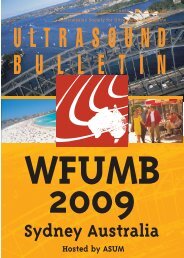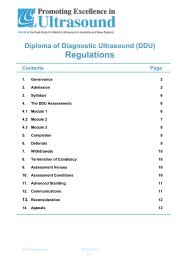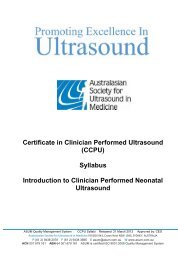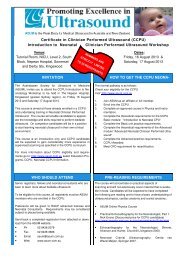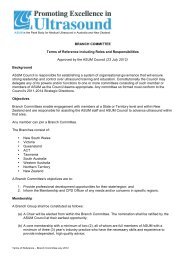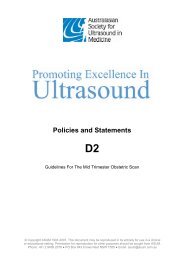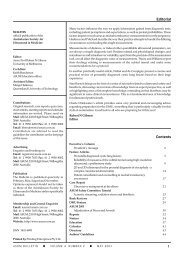Volume 11 Issue 1 (February) - Australasian Society for Ultrasound ...
Volume 11 Issue 1 (February) - Australasian Society for Ultrasound ...
Volume 11 Issue 1 (February) - Australasian Society for Ultrasound ...
You also want an ePaper? Increase the reach of your titles
YUMPU automatically turns print PDFs into web optimized ePapers that Google loves.
Fetal intracranial abnormalities in the third trimester – MRI as a useful diagnostic tool<br />
the cyst is lined by white matter. This case highlights the<br />
limitations of USS and MRI prenatally, and demonstrates<br />
how it may not be possible to make a definitive diagnosis<br />
until after birth.<br />
In the case of massive subarachnoid haemorrhage, the<br />
resulting compression of the fetal brain made ultrasound<br />
assessment of CNS anatomy difficult, and MRI was per<strong>for</strong>med<br />
to ascertain whether the haemorrhage was the<br />
primary event responsible <strong>for</strong> the rapidly enlarging head<br />
size, or whether the bleed was secondary to some other<br />
underlying abnormality such as a tumour. The antenatal<br />
MRI images were subsequently reviewed by paediatric<br />
radiologists and neurosurgeons, and the area of haemorrhage<br />
(which was subsequently confirmed on post-mortem<br />
examination) was mistakenly reported as an intracranial<br />
tumour. This case demonstrates the advantages of real time<br />
imaging and dynamic assessment achieved with ultrasound,<br />
and the importance of combining in<strong>for</strong>mation obtained from<br />
all imaging modalities to increase diagnostic accuracy.<br />
In summary, fetal MRI has been reported as a valuable diagnostic<br />
aid when investigating intracranial pathology, and it had<br />
a major impact on the decision making processes and eventual<br />
pregnancy outcomes in all three cases we have reported. Fetal<br />
MRI has only recently been undertaken in our institution and<br />
perhaps this at least partially accounts <strong>for</strong> why there was a<br />
minor diagnostic discrepancy in one case (schizencephaly) and<br />
misdiagnosis in another (intracranial haemorrhage).<br />
Acknowledgements<br />
The authors gratefully acknowledge the assistance of<br />
the medical imaging department at Nepean Hospital and<br />
Professor Albert Lam at Westmead Children’s hospital.<br />
2 Aguirre Vila-Coro A, Dominguez R. Intrauterine diagnosis of hydranencephaly<br />
by magnetic resonance. Mag Res Imaging 1989; 7: 105–7.<br />
3 Ismail KMK, Ashworth JR, Martin WL, Chapman S, McHugo J,<br />
Whittle MJ, Kilby MD. Fetal magnetic resonance imaging in prenatal<br />
diagnosis of central nervous system abnormalities: three-year experience.<br />
J Mat Fet Neonat Med 2002; 12: 185–90.<br />
4 Wolff S, Crooks LE, Brown P, Howard R, Painter RB. Tests <strong>for</strong> DNA<br />
and chromosomal damage induced by nuclear magnetic resonance<br />
imaging. Radiology 1980; 136: 707–10.<br />
5 Baker PN, Johnson IR, Harvey PR, Gowland PA, Mansfield P. A threeyear<br />
follow-up of children imaged in utero using echo planar magnetic<br />
resonance. Am J Obstet Gynecol 1994; 170: 32–3.<br />
6 Twickler DM, Magee KP, Caire J, Zaretsky M, Fleckenstein JL, Ramus<br />
RM. Second-opinion magnetic resonance imaging <strong>for</strong> suspected fetal<br />
central nervous system abnormalities. Am J Obstet Gynecol 2003; 188<br />
(2): 492–96.<br />
7 Patel MD, Filly AL, Hersh DR, Goldstein RB. Isolated mild fetal cerebral<br />
ventriculomegaly: Clinical course and outcome. Radiology 1994;<br />
192: 759–64.<br />
8 Vintzileos AM, Campbell WA, Weinbaum PJ, Nochimson DJ. Perinatal<br />
management and outcome of fetal ventriculomegaly. Obstet Gynecol<br />
1987; 69: 5–<strong>11</strong>.<br />
9 Whitby E, Paley MN, Davies N, Sprigg A, Griffiths PD. Ultrafast magnetic<br />
resonance imaging of central nervous system abnormalities in<br />
utero in the second and third trimester of pregnancy: comparison with<br />
ultrasound. Br J Obstet Gynecol 2001; 108: 519–26.<br />
10 Whitby EH, Paley MNJ, Sprigg A, Rutter S, Davies NP, Wilkinson<br />
ID, Griffiths PD. Comparison of ultrasound and magnetic resonance<br />
imaging in 100 singleton pregnancies with suspected brain abnormalities.<br />
Br J Obstet Gynecol 2004; <strong>11</strong>1: 784–92.<br />
<strong>11</strong> Malinger G, Ben-Sira L, Lev D, Ben-Aroya Z, Kidron D, Lerman-<br />
Sagie T. Fetal brain imaging: a comparison between magnetic resonance<br />
imaging and dedicated neurosonography. <strong>Ultrasound</strong> Obstet<br />
Gynecol 2004; 23: 333–40.<br />
References<br />
1 Levine D, Barnes PD, Madsen JR, Abbott J, Mehta T, Edelman RR.<br />
Central nervous system abnormalities assessed with prenatal magnetic<br />
resonance imaging. Obstet Gynecol 1999; 94: 10<strong>11</strong>–19.<br />
ASUM <strong>Ultrasound</strong> Bulletin 2008 <strong>February</strong> <strong>11</strong> (1)


